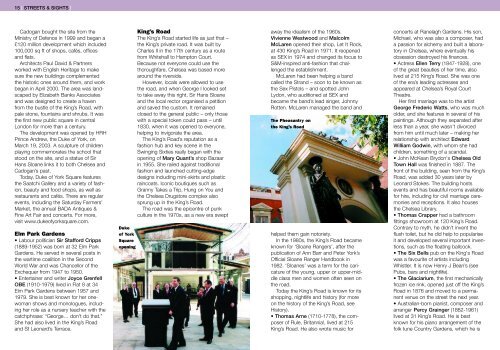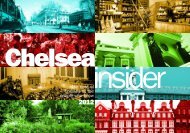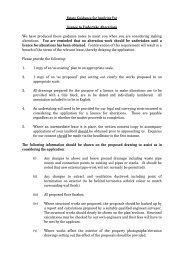Chelsea Insider Low - Cadogan
Chelsea Insider Low - Cadogan
Chelsea Insider Low - Cadogan
- No tags were found...
You also want an ePaper? Increase the reach of your titles
YUMPU automatically turns print PDFs into web optimized ePapers that Google loves.
15 | STREETS & SIGHTS |<strong>Cadogan</strong> bought the site from theMinistry of Defence in 1999 and began a£120 million development which included100,000 sq ft of shops, cafés, officesand flats.Architects Paul David & Partnersworked with English Heritage to makesure the new buildings complementedthe historic ones around them, and workbegan in April 2000. The area was landscapedby Elizabeth Banks Associatesand was designed to create a havenfrom the bustle of the King’s Road, withpale stone, fountains and shrubs. It wasthe first new public square in centralLondon for more than a century.The development was opened by HRHPrince Andrew, the Duke of York, onMarch 19, 2003. A sculpture of childrenplaying commemorates the school thatstood on the site, and a statue of SirHans Sloane links it to both <strong>Chelsea</strong> and<strong>Cadogan</strong>’s past.Today, Duke of York Square featuresthe Saatchi Gallery and a variety of fashion,beauty and food shops, as well asrestaurants and cafés. There are regularevents, including the Saturday Farmers'Market, the annual BADA Antiques &Fine Art Fair and concerts. For more,visit www.dukeofyorksquare.com.Elm Park Gardens• Labour politician Sir Stafford Cripps(1889-1952) was born at 32 Elm ParkGardens. He served in several posts inthe wartime coalition in the SecondWorld War and was Chancellor of theExchequer from 1947 to 1950.• Entertainer and writer Joyce GrenfellOBE (1910-1979) lived in Flat 8 at 34Elm Park Gardens between 1957 and1979. She is best known for her onewomanshows and monologues, includingher role as a nursery teacher with thecatchphrase: “George… don’t do that.”She had also lived in the King’s Roadand St Leonard’s Terrace.Dukeof YorkSquareopeningKing’s RoadThe King’s Road started life as just that –the King’s private road. It was built byCharles II in the 17th century as a routefrom Whitehall to Hampton Court.Because not everyone could use thethoroughfare, <strong>Chelsea</strong> was based morearound the riverside.However, locals were allowed to usethe road, and when George I looked setto take away this right, Sir Hans Sloaneand the local rector organised a petitionand saved the custom. It remainedclosed to the general public – only thosewith a special token could pass – until1830, when it was opened to everyone,helping to invigorate the area.The King’s Road’s reputation as afashion hub and key scene in theSwinging Sixties really began with theopening of Mary Quant’s shop Bazaarin 1955. She railed against traditionalfashion and launched cutting-edgedesigns including mini-skirts and plasticraincoats. Iconic boutiques such asGranny Takes a Trip, Hung on You andthe <strong>Chelsea</strong> Drugstore complex alsosprung up in the King’s Road.The road was the epicentre of punkculture in the 1970s, as a new era sweptaway the idealism of the 1960s.Vivienne Westwood and MalcolmMcLaren opened their shop, Let It Rock,at 430 King’s Road in 1971. It reopenedas SEX in 1974 and changed its focus toS&M-inspired anti-fashion that challengedthe establishment.McLaren had been helping a bandcalled the Strand – soon to be known asthe Sex Pistols – and spotted JohnLydon, who auditioned at SEX andbecame the band’s lead singer, JohnnyRotten. McLaren managed the band andThe Pheasantry onthe King’s Roadhelped them gain notoriety.In the 1980s, the King’s Road becameknown for ‘Sloane Rangers’, after thepublication of Ann Barr and Peter York’sOfficial Sloane Ranger Handbook in1982. ‘Sloanes’ was a term for the caricatureof the young, upper or upper-middleclass men and women often seen onthe road.Today the King’s Road is known for itsshopping, nightlife and history (for moreon the history of the King’s Road, seeHistory).• Thomas Arne (1710-1778), the composerof Rule, Britannia!, lived at 215King’s Road. He also wrote music forconcerts at Ranelagh Gardens. His son,Michael, who was also a composer, hada passion for alchemy and built a laboratoryin <strong>Chelsea</strong>, where eventually hisobsession destroyed his finances.• Actress Ellen Terry (1847-1928), oneof the great beauties of her time, alsolived at 215 King’s Road. She was oneof the era’s leading actresses andappeared at <strong>Chelsea</strong>’s Royal CourtTheatre.Her first marriage was to the artistGeorge Frederic Watts, who was mucholder, and she features in several of hispaintings. Although they separated afterless than a year, she wasn’t divorcedfrom him until much later – making herrelationship with architect EdwardWilliam Godwin, with whom she hadchildren, something of a scandal.• John McKean Brydon's <strong>Chelsea</strong> OldTown Hall was finished in 1887. Thefront of the building, seen from the King’sRoad, was added 30 years later byLeonard Stokes. The building hostsevents and has beautiful rooms availablefor hire, including for civil marriage ceremoniesand receptions. It also housesthe <strong>Chelsea</strong> Library.• Thomas Crapper had a bathroomfittings showroom at 120 King’s Road.Contrary to myth, he didn’t invent theflush toilet, but he did help to populariseit and developed several important inventions,such as the floating ballcock.• The Six Bells pub on the King's Roadwas a favourite of artists includingWhistler. It is now Henry J Bean’s (seePubs, bars and nightlife).• The Glaciarium, the first mechanicallyfrozen ice rink, opened just off the King’sRoad in 1876 and moved to a permanentvenue on the street the next year.• Australian-born pianist, composer andarranger Percy Grainger (1882-1961)lived at 31 King’s Road. He is bestknown for his piano arrangement of thefolk tune Country Gardens, which he is







